|
|
|
Sort Order |
|
|
|
Items / Page
|
|
|
|
|
|
|
| Srl | Item |
| 1 |
ID:
152355
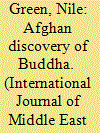

|
|
|
|
|
| Summary/Abstract |
Through their interactions with French archaeologists from around 1930, Afghan historians formulated a new official historical identity for Afghanistan based on its pre-Islamic past. This article provides the first analysis of this process by tracing the emergence of the new historiography through the career of its chief promoter, Ahmad ʿAli Kuhzad, as curator of the National Museum (founded 1931) and director of the Afghan Historical Society (founded 1942). Through placing Kuhzad in these official institutional settings and reading his major works, the article shows how traditional Persianate historiography was challenged by an imported and amended version of world civilizational history. In the decades after independence in 1919, this new historical vision allowed the young Afghan nation-state to stake its civilizational claims on an international stage. In these previously unexcavated historiographical strata lie the roots of the Taliban's iconoclasm, which are revealed as a dialogical response to the state cultural institutions that remade Afghanistan as Aryana.
|
|
|
|
|
|
|
|
|
|
|
|
|
|
|
|
| 2 |
ID:
152362


|
|
|
|
|
| Summary/Abstract |
In our imperfect world, rape happens frequently but nearly no one publicly defends the legitimacy of forcible or nonconsensual sex. So pervasive is deference to some notion of consent that even Daʿish supporters who uphold the permissibility of enslaving women captured in war can insist that their refusal or resistance makes sex unlawful. Apparently, one can simultaneously laud slave concubinage and anathematize rape. A surprising assertion about consent also appears in a recent monograph by a scholar of Islamic legal history who declares in passing that the Qurʾan forbids nonconsensual relationships between owners and their female slaves, claiming that “the master–slave relationship creates a status through which sexual relations may become licit, provided both parties consent.” She contends that “the sources” treat a master's nonconsensual sex with his female slave as “tantamount to the crime of zinā [illicit sex] and/or rape.” Though I believe in the strongest possible terms that meaningful consent is a prerequisite for ethical sexual relationships, I am at a loss to find this stance mirrored in the premodern Muslim legal tradition, which accepted and regulated slavery, including sex between male masters and their female slaves.
|
|
|
|
|
|
|
|
|
|
|
|
|
|
|
|
| 3 |
ID:
152358
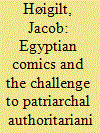

|
|
|
|
|
| Summary/Abstract |
Adult comics are a new medium in the Arab world. This article is the first in-depth study of their emergence and role within Arab societies. Focused on Egypt, it shows how adult comics have boldly addressed political and social questions. Seeing them as part of a broader cultural efflorescence in Egypt, I argue that, against patriarchal authoritarianism, adult comics have expressed an alternative ideology of tolerance, civic rights and duties, individualism, creativity, and criticism of power. Specifically, they present a damning critique of Egypt's authoritarian order, as well as of the marginalization of women and broader gender dynamics in Egyptian society. Through frank humor, a playful style, and explicit graphics, they give voice to the concerns of young Egyptians. Connecting comics to other art forms such as music, graffiti, and political cartoons, I situate them within a critical cultural movement that came to the fore with the Egyptian uprising of 2011.
|
|
|
|
|
|
|
|
|
|
|
|
|
|
|
|
| 4 |
ID:
152353
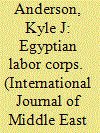

|
|
|
|
|
| Summary/Abstract |
In this article, I detail the British imperial system of human resource mobilization that recruited workers and peasants from Egypt to serve in the Egyptian Labor Corps in World War I (1914–18). By reconstructing multiple iterations of this network and analyzing the ways that workers and peasants acted within its constraints, this article provides a case study in the relationship between the Anglo-Egyptian colonial state and rural society in Egypt. Rather than seeing these as two separate, autonomous, and mutually antagonistic entities, this history of Egyptian Labor Corps recruitment demonstrates their mutual interdependence, emphasizing the dialectical relationship between state power and political subjectivity.
|
|
|
|
|
|
|
|
|
|
|
|
|
|
|
|
| 5 |
ID:
152367


|
|
|
|
|
| Summary/Abstract |
If historians of the Middle East have turned their attention to the environment rather later than those in other subfields, a recent crop of books indicates that a new generation of scholars has spent much productive time considering environmental histories of other geographies. The books reviewed in this essay stand out for their insistence on examining Middle Eastern environments as both ecological facts and representational spaces. Taken in concert, they indicate the vibrancy of environmental history in the field. Moreover, their careful attention to methodology and creative use of sources opens up spaces for new investigations of politics, culture, and religion as mediated through environmental management and representation. Following on the recent work of Diana K. Davis, Edmund Burke III, and others, these historians have marshaled environmental, climatological, epidemiological, biological, and geological data for historical argument. Thus, the resulting works situate themselves deeply within their respective historiographic narratives, yet also interrupt, redelineate, and unsettle those narrative assumptions. At its best, the so-called “environmental turn” in the history of the Middle East represents not an intellectual fashion, but rather a major methodological shift that involves a reframing of our understanding of the formation of the field.
|
|
|
|
|
|
|
|
|
|
|
|
|
|
|
|
| 6 |
ID:
152356
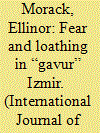

|
|
|
|
|
| Summary/Abstract |
Based on a series of recollections published between January and April 1926 in the Izmir-based daily newspaper Ahenk (Harmony), this article explores how individual Muslim Turks remembered their emotional responses to the Greek occupation of that city (May 1919–September 1922). Analyzing these recollections, it considers why certain events were remembered while others were almost completely left out. By studying how Muslim Turks described their feelings towards the occupying forces, local non-Muslims, and the eventually victorious Turkish army, the article makes an initial contribution to the history of emotions in early republican Turkey. I argue that the composition and consumption of memories were avenues for connecting emotionally to the Turkish nationalist project. This finding challenges the widespread notion that the early republican period was characterized by collective amnesia of the immediate past, and contributes to the growing body of scholarship on popular participation in early republican nationalism.
|
|
|
|
|
|
|
|
|
|
|
|
|
|
|
|
| 7 |
ID:
152359


|
|
|
|
|
| Summary/Abstract |
As Nadia Maria El Cheikh has said of the harem in western scholarship on the premodern Islamic world, slavery and the slave trade have yet to be fully historicized. While scholars of Abbasid-era slavery have made tremendous contributions in this regard over the last two decades, there remain ample opportunities to expand the chronological and geographic scope of their work. What does it mean to historicize slavery in the medieval Islamic Middle East and why is it worth doing?
|
|
|
|
|
|
|
|
|
|
|
|
|
|
|
|
| 8 |
ID:
152365
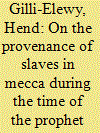

|
|
|
|
|
| Summary/Abstract |
There is hardly a source on early Islam that does not mention slaves in one way or another. They were ubiquitous companions of events, occasions, and incidences. But they played marginal roles in historical accounts. The numerous fragments of information, anecdotes, and offhand references concerning slaves during the rise of Islam call to be collected and analyzed to piece together a picture of various aspects of slavery during this period. References to slaves are especially prevalent in legal texts, as slaves provided useful cases to Muslim jurists to think through legal questions. The discussion of examples of slaves, walāʾ (clientele relationships), and manumission in hadith, exegesis, and jurisprudence has not only provided significant insight into the legal status of slaves, but has also helped scholars to develop a methodology for verifying and evaluating the source material itself. In this essay, I examine pieces of information available in historical and biographical works on early Islam to address the question of the provenance and procurement of slaves in Mecca, Medina, and the Hijaz during the time of the Prophet Muhammad. Reconstructing this story involves dealing with narratives transmitted in various short, spurious, and often unrelated accounts. The source material for early Islam is, as is often pointed out, problematic and at times contradictory. It is laced with topoi and leitmotifs, and frequently proves tendentious, reflecting the opinions and biases of those who wrote them more than what actually happened. Nevertheless, reading beyond the topoi, leitmotifs, and tendentiousness, we find that “in the Traditions there is an undeniable core of ‘fact’” with which we can work and assume to be valid until shown to be false.
|
|
|
|
|
|
|
|
|
|
|
|
|
|
|
|
| 9 |
ID:
152354
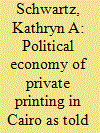

|
|
|
|
|
| Summary/Abstract |
This article examines the political economy of Cairo's emerging Arabic private printing industry during the third quarter of the 19th century. I use the constituent texts of the industry to demonstrate that it developed upon the speculative model of commissioning, whereby individuals paid printers to produce particular works of their choosing. Commissioning indicates that Egyptian private printing grew from local traditions for producing handwritten texts. Nevertheless, print commissioning differed from manuscript commissioning by requiring individuals to assume great financial risk. I explore the nature and implications of this divergence through a treatise published in 1871 by Musa Kastali, a particularly prolific printer who helped to professionalize Cairene printing. Musa's treatise details his legal battle with a famous Azhari commissioner, and is unique for describing a printer's business practices. It demonstrates the importance of situating printings within their socioeconomic contexts in addition to their intellectual ones, a task which cannot be done without an appreciation for the functioning of the printing industry at a local level.
|
|
|
|
|
|
|
|
|
|
|
|
|
|
|
|
| 10 |
ID:
152360
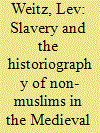

|
|
|
|
|
| Summary/Abstract |
The study of non-Muslims in Islamic societies has long been a robust subfield in the historiography of the medieval Middle East. But its literature has blind spots, a significant example of which concerns slavery as a constitutive institution of non-Muslim communities. Much recent scholarship on medieval non-Muslims has tended to privilege religious affiliation as an explanatory category of social experience, leaving other legal statuses and modes of identification—especially slavery—underanalyzed. This piece will survey this historiographical hole. It will then offer a brief analysis of some Abbasid-era Syriac Christian material in which slavery figures prominently, concubines and concubinage in particular. My goal is to provide an example of how attending to the place of slavery in non-Muslim communities facilitates a much-needed historiographical shift of focus from reified religious identities to the social practices, institutions, and hierarchies upon which those communities were built.
|
|
|
|
|
|
|
|
|
|
|
|
|
|
|
|
| 11 |
ID:
152364


|
|
|
|
|
| Summary/Abstract |
Abu ʿUbayda (d. 825) was a mawlā (client) of Jewish descent who wrote prolifically about history, religion, and culture. As such, he exemplifies the well-known feature of early Islamic learning that is the Abbasid-era mawlā scholar. His grandfather was a freeborn convert, rather than the more common manumitted slave, and it happens that the grandfather's patron—his sponsor, as it were, for admission into Islamic society—was a slave trader named ʿUbayd Allah b. Maʿmar (d. ca. 665). And ʿUbayd Allah b. Maʿmar, on a conservative estimate, had purchased hundreds of slaves from ʿUmar b. al-Khattab, the caliph who, before his assassination by a slave, had presided over the explosive early phases of the Islamic conquests.
|
|
|
|
|
|
|
|
|
|
|
|
|
|
|
|
| 12 |
ID:
152361


|
|
|
|
|
| Summary/Abstract |
The idea that there can be histories of everything or anything has not yet taken root in the field of Islamic history, which is still dominated by political history. There has been a revival of women's history, and gender studies is flourishing, but these developments have brought about only one radical rethinking of mainstream narratives: Nadia Maria El Cheikh's Women, Islam, and Abbasid Identity, which argues that Abbasid society's construction of early Islam and of its own self-image is profoundly gendered, because “Women, gender relations, and sexuality are at the heart of the cultural construction of identity, as they are discursively used to fix moral boundaries and consolidate particularities and differences.”
|
|
|
|
|
|
|
|
|
|
|
|
|
|
|
|
| 13 |
ID:
152363


|
|
|
|
|
| Summary/Abstract |
Contemporary and later Arabic texts provide much evidence that wayward conduct by elite young adult males was a source of considerable stress in early Abbasid cities. This brief essay turns on a question: to what extent is such conduct to be attributed to concubinage? I treat two sample texts, each describing untoward activity on the part of well-placed adult sons and its impact on the Abbasid body politic. Neither text, however, speaks to concubinage. What follows, then, is an argument from circumstantial evidence. Concubinage seems a most likely source, and so can reasonably be connected to the broader patterns of social disjunction of the first Abbasid period (roughly the mid-8th to mid-10th centuries).
|
|
|
|
|
|
|
|
|
|
|
|
|
|
|
|
| 14 |
ID:
152357


|
|
|
|
|
| Summary/Abstract |
Connecting the stories of human rights violations perpetrated by the Syrian regime against the children of Darʿa in March 2011 to decades of writings about political detention in Syria, this article argues that particular works of Syrian prison literature (adab al-sujūn) articulate a poetics of recognition that both reaffirms and challenges the foundational dependency on political recognition in human rights theory. By focusing on narrative scenes of recognition and misrecognition, I contend that these texts, much like the stories of the children of Darʿa, depict different forms of acute human vulnerability. In doing so, they offer a mode of sentimental education that evokes readers’ empathy and awareness of human suffering. Yet such texts also demonstrate, in allegorical form, how the foundational reliance on political recognition in human rights regimes can limit their efficacy.
|
|
|
|
|
|
|
|
|
|
|
|
|
|
|
|
| 15 |
ID:
152366
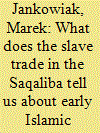

|
|
|
|
|
| Summary/Abstract |
The Saqaliba—a term that in medieval Arabic literature denoted the Slavic populations of central and eastern Europe (and possibly some of their neighbors)—offer a particularly insightful case study of the mechanisms of the early Islamic slave trade and the nature of the Muslim demand for slaves. What makes them such an ideal case study is their high visibility in texts produced in the Islamic world between the early 9th and early 11th centuries. Arab geographers and diplomats investigated their origins, while archaeological material, primarily hundreds of thousands of dirhams found in Scandinavia and the Slavic lands, contains traces of the trade in them. By combining these strands of evidence, we can build an exceptionally detailed image of slave trade systems that supplied Saqaliba to the Islamic markets, which, in turn, can be used to illustrate more general mechanisms governing the trade in and demand for slaves in the medieval Islamic world.
|
|
|
|
|
|
|
|
|
|
|
|
|
|
|
|
|
|
|
|
|